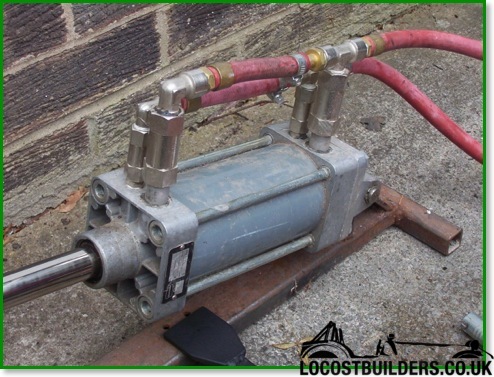
might not be for you but i used to get lpg from an upturned 47kg cyl using one of these made your arm ache i suppose you could motorise it mine was on a hand lever
[Edited on 27/12/17 by rash12]
[Edited on 27/12/17 by rash12]

Or more specifically, pumping it from one tank to another?
Scenario is this: I bought an LPG-powered Jeep. I wanted a cheap runabout that could pull a decent sized trailer and deal with the odd bit of mild
off-roading (mainly dragging said trailer through a field) and it fits the bill nicely. OK it only does 15-ish mpg but with LPG being about half the
price of petrol I get the equivalent cost of about 30mpg whilst still being able to drive about in a 4.7 v8.
What is getting on my nerves however is having to fill it up. It only has a 70l tank which, once you take into account only being able to fill it to
80% (standard practice to leave expansion room) means only 55l of LPG available and therefore about 150-160 miles between trips to the only LPG
supplier around which just happens to be completely the opposite end of town to where I live.
Clearly if I had some way of buying in bulk and filling the car up myself life would be a lot easier. The gas is the same stuff as used for heating,
and there is a process with HMRC (Google C&E930B if you are interested) for declaring that you have used heating gas as road fuel and paying the
difference in duty, the issue is one of getting the LPG from a bulk tank into the car.
I have managed to acquire a 1000l tank with a bottom outlet (required to get the contents out as liquid) I now just need some method of pumping the
gas from there into the car. Has anyone attempted something like this before?
As I understand it, I need a positive displacement pump. The commercial installations use a gear type pump but 'proper' LPG ones (eg from
Smith pumps in the US) are expensive. I have also heard of DIY'ers using sliding vane type although apparently there is some issue of cavitation
at the tips of the vanes causing the liquid to turn to gas and massively reducing the efficiency of the pump (I don't profess to understand the
physics behind that).
Would a gear type hydraulic pump do the job? If so, will the LPG act as a lubricant or am I going to either have to make some other arrangements to
lubricate or just accept that the pump will die over a period of time?
What about a car air-con pump? These are usually piston type pumps with a non-return valve at each end. I hesitate here as I was taught when I did
my F-gas certificate that allowing liquid in to AC pumps was the most common way of killing them but I have no idea why that is. My only guess is
that it is something to do with the non-return valves.
Anyone got any experiences or advice they can offer?
Chris
Can't help with the original question but is there such a thing as "red" LPG? IE what's to stop people using heating LPG for cars? Or do they just assume the number of LPG cars is quite low and the number of people who have the knowledge to transfer LPG without flame-throwering themselves even less so???
Loads of forklifts run on LPG and I assume they get filled on site so I guess smallish bulk equipment must be available. Also some of the small LPG
filling stations look like they have pretty basic equipment.
Couldn't you just connect the tanks without a pump and have a bit more pressure in the external tank to force it to the car tank. Or pressurise
it with welding gas. I'm sure the pressure in the car tank is pretty low (2bar rings a bell).
I don't think LPG is taxed at all so not sure buying heating gas will be any cheaper although I guess buying in bulk is.
quote:
Originally posted by BenB
Can't help with the original question but is there such a thing as "red" LPG? IE what's to stop people using heating LPG for cars? Or do they just assume the number of LPG cars is quite low and the number of people who have the knowledge to transfer LPG without flame-throwering themselves even less so???
quote:
Originally posted by ChrisW
The gas is the same stuff as used for heating, and there is a process with HMRC (Google C&E930B if you are interested) for declaring that you have used heating gas as road fuel and paying the difference in duty, the issue is one of getting the LPG from a bulk tank into the car.
quote:
Originally posted by luke2152
Loads of forklifts run on LPG and I assume they get filled on site so I guess smallish bulk equipment must be available. Also some of the small LPG filling stations look like they have pretty basic equipment.
quote:
Originally posted by luke2152
Couldn't you just connect the tanks without a pump and have a bit more pressure in the external tank to force it to the car tank. Or pressurise it with welding gas. I'm sure the pressure in the car tank is pretty low (2bar rings a bell).
quote:
Originally posted by luke2152
I don't think LPG is taxed at all so not sure buying heating gas will be any cheaper although I guess buying in bulk is.

might not be for you but i used to get lpg from an upturned 47kg cyl using one of these made your arm ache i suppose you could motorise it mine was on
a hand lever
[Edited on 27/12/17 by rash12]
[Edited on 27/12/17 by rash12]
That looks like the one on the DIY-LPG site here.
Tinley Tech sell them pre-made here but not sure I want to hand pump it each
time. You are right though I could potentially motorise it.
I was thinking of buying something like this: eBay Item. OK it will be slow (4 litres per minute) but I can just hook it up and leave
it running for ~15 mins. It is a gear type pump like the 'proper' ones. Has anyone got any comments on whether this will work or not?
Chris
thats where i got the plans from worked well used it for a couple of years
Is fitting a larger or second lpg tank not an option?
quote:
Originally posted by 02GF74
Is fitting a larger or second lpg tank not an option?
I have never pumped LPG, but have been involved with liquid transfer many times over the years. My first point of call for a positive displacement
pump
with known reliability would be an air operated diaphragm pump and my choice of manufacturer would be Blagdon. They are not cheap and would probably
eat into the cost saving between LPG and other fuels.
Once read an article in some Cumbria mag about an Estate agent who worked around Coniston running a massive engined Range Rover and he had a tank at
home to top it up so it can be done. We use lpg for heating but tank belongs to Shell. If you are buying bulk could you not get a free tank and pump
from a supplier?
Atb
Mike
I used to invert 47kg cylinders and pump them into my Range Rover, less than 25p per litre, used to go through 4 a month.
I started off with a vane type pump, slow and fell apart so moved onto a quality diapham pump that was pretty quick although cost maybe £250 at the
time, it was a quality bit of kit.
Looked like this. Lpg Transfer Pump
The problem is LPG rotting the seals.
[Edited on 28/12/17 by mark chandler]
Back in the days working as an interpreter I remember a Video about an accident involving propane and Liquid transfer in Ghent, W.Va.
Shouldn“t be that hard to google.
Not to discourage you, but to make sure you review and heed all safety procedures before attempting such transfers.
Found the page and video of the accident recap...
http://www.csb.gov/csb-safety-recommendations-from-ghent-west-virginia-propane-explosion-largely-adopted-effecting-life-saving-change/
Link to video on page...
A few of the rdcs I go with my truck have a big tank and the forklift drivers fill the cylinders from it. Not sure how it works but next time
I'm there I'll take a picture of the pump arrangement.
Might be while yet like cause I'm sunning mesell in Tenerife atm...
Having worked with LPG professionally for years (decade and a half) I only have one advice: don't do what you are planning. Transferring LPG from
one tank to another regularly, safely and reliably isn't a DIY proposition. Having a modified 1000L tank at home also isn't. Just think what
will happen if one of your fittings fail.
Sorry to be the bearer of bad news. I'm usually all for doing stuff yourself, but this is just a bad idea and possibly lethal...
First off, thanks for the comments everyone.
quote:
Originally posted by mark chandler
I used to invert 47kg cylinders and pump them into my Range Rover, less than 25p per litre, used to go through 4 a month.
quote:
Originally posted by mark chandler
I started off with a vane type pump, slow and fell apart so moved onto a quality diapham pump that was pretty quick although cost maybe £250 at the time, it was a quality bit of kit.
quote:
Originally posted by coozer
A few of the rdcs I go with my truck have a big tank and the forklift drivers fill the cylinders from it. Not sure how it works but next time I'm there I'll take a picture of the pump arrangement.
quote:
Originally posted by sebastiaan
Having worked with LPG professionally for years (decade and a half) I only have one advice: don't do what you are planning. Transferring LPG from one tank to another regularly, safely and reliably isn't a DIY proposition. Having a modified 1000L tank at home also isn't. Just think what will happen if one of your fittings fail.
I wonder what your house insurance would say if you blew up the place...?
Sure in theory all this is very simple, in concept but I'm sure there is very good reason these things tend to be regulated. I too am looking at
LPG for my Landy but will not be making my own filling station at home.
[Edited on 4/1/18 by Mr Whippy]
quote:
Originally posted by ChrisW
The rig will be on a farm in the middle of nowhere, not in an enclosed back garden or with people in close proximity
yeah I use to have a LPG tank in the garden too, can't say I was ever trying to connect my car to it though. These things kind of escalate rather
quickly if they go wrong. 1000ltrs, that's a lot of gas to go bang if it did, mushroom cloud kind of scale, crater in the ground...
I'm not saying don't do it, just do it very very very carefully. I'd be most concerned if the regulator or valve failed and the full
force and volume of the gas in the tank tried to get out. Isn't it like 300psi normally in a tank, more in hot weather? you ain't plugging
that with your finger. Tbh I shudder when I see some of the contraptions people make on the web though.
Pity the Jeep has such a huge engine, probably produces very little power for it's size
[Edited on 4/1/18 by Mr Whippy]
Whilst i run my van on lpg, i don't have a home filling set-up. I do know a few people that do/have though, and none reported any issues what so
ever. The only thing some said was if the big tank is being filled for domestic use (cheaper), they quite often check for a bottom take off
pipe/indications someone using it to fill a vehicle. Of course that wouldn't be so easy to check if someone had a top fitting with a dip
tube..lol. I never asked them about the transfer/pump so i can't help on that one but reading above it looks like you've done a bit
research, crack on 
Ian
quote:
Originally posted by Oddified
The only thing some said was if the big tank is being filled for domestic use (cheaper), they quite often check for a bottom take off pipe/indications someone using it to fill a vehicle.

you seem to be mixing fluids/gasses in different items are you sure the material in the seals etc are all compatible?, propane in ac or hydraulic
equipment. Another thought is the effects of cold, O-rings for hydraulics are unlikely to be happy if they are chilled.
might be worth checking....
I believe you need a licence for filling vehicles with LPG. The LGP 'petrol' station will have one issued by the local fire brigade.
We used to have one for LPG when we ran LPG engines on the test bed. As for transferring from one tank to another its a real headache. You need to
ensure the pressure in the bulk tank is greater than the vehicle tank and by some margin or you'll transfer very little and the pressure changes
depending on the temperature. Also the bulk tank will be considered a pressure vessel so you made need regular certification. Can you not fit a bigger
vehicle tank to reduce the trips to the filling station?
quote:
Originally posted by Mr Whippy
you seem to be mixing fluids/gasses in different items are you sure the material in the seals etc are all compatible?, propane in ac or hydraulic equipment. Another thought is the effects of cold, O-rings for hydraulics are unlikely to be happy if they are chilled.
quote:
Originally posted by chillis
I believe you need a licence for filling vehicles with LPG. The LGP 'petrol' station will have one issued by the local fire brigade.
FYI, gear pump will have a rubber seal on the driveshaft and also the end plates will be sealed using rubber seals. Should you need to reseal then
kits are usually available in Viton which is compatible with LPG.
How will you drive the pump?
Very interests in the outcome of this.
Regards
Davies
quote:
Originally posted by daviep
FYI, gear pump will have a rubber seal on the driveshaft and also the end plates will be sealed using rubber seals. Should you need to reseal then kits are usually available in Viton which is compatible with LPG.
How will you drive the pump?
Update: got all the big parts here. Need a trip to Screwfix to get some jubilee clips and to knock something up to safely activate the contactor at a
safe distance from where gas has the potential to escape.
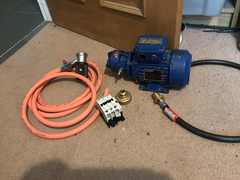

lpg pump bits
Have also got a 19kg orange cylinder to use as my first test. Actually more expensive per litre than buying 'real' LPG but it means I can
try the rig out without loosing too much money if it doesn't work. See previous posts for the reason why I have selected 19kg as the first
trial.
Only problem now is I have a full tank of gas in the car so it will be a couple of days before I can try this all out. If you see a mushroom cloud
over a North Buckinghamshire farm you will know why! 
Chris
quote:I've seen lots of things saying not to use jubilee clips on fuel hoses since they tend not to clamp evenly all round
Originally posted by ChrisW
Need a trip to Screwfix to get some jubilee clips
quote:
Originally posted by gremlin1234
quote:I've seen lots of things saying not to use jubilee clips on fuel hoses since they tend not to clamp evenly all round
Originally posted by ChrisW
Need a trip to Screwfix to get some jubilee clips
yeah...he's still alive 
Ok, so for anyone following along at home I have had some success (I think) with this tonight.
First problem I came across was it appeared the pump was not gas tight. I took it apart to find out why (I figured I had nothing to loose) and it
seems the rear seal was not seated correctly. If you are interested, here is what it looks like inside.
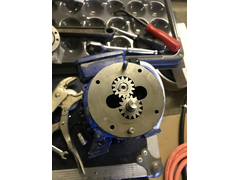

LPG rig test 3
I cleaned everything out, wiped out the remnants of hydraulic oil, and put it all back together. All seemed good from both a sniff test (no gas
smell) and ear test (can't hear any hissing). Next time I go up to the yard I will take some fairy liquid and double check that there are no
weeps from anywhere.
It is worth saying that I had the pump on about 10m of cable so I could stand well back and activate it just in case anything bad happened. The down
side of this was I was I could not hear if anything was going wrong, any gas escaping, etc whilst operating the pump.
So anyway, I hooked everything up but didn't connect to the car, and tested running the pump to see if I could get it to prime. It seems there
is some kind of stop valve mechanism in the propane tank fitting that I managed to activate the first time I tried, I think because I was being very
cautious about opening all the valves at once and probably managed to create a vacuum somewhere. The second time I just opened all but the valve on
the car filler end, ran the pump for a few seconds and hey presto I had liquid when I cracked open the valve at the car filler end.
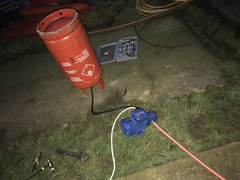

LPG rig test 2
Then hooked it up to the car and weighed the cylinder so I had a starting position. Ran the pump for a few seconds, went over and checked for any
signs of leaks, few more seconds, re-check, etc. Did that until I had 30 seconds of pump run time. Checked the cylinder and the weight had dropped
indicating transfer of gas. Started running for longer bursts. First 10 seconds at a time, then 20s, then 30s, then eventually a minute at a time
checking cylinder weight between each run.
Should also say at this point the car was not empty so I wasn't able to say with accuracy how much space was in the tank. As I have no pressure
relief at the moment it was important that I did not get to the limit of the car tank's fill valve. I took a conservative estimate of the gas
used since the last fill (based on miles) and halved that to set a max I was going to attempt to fill today.
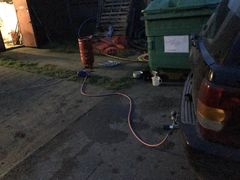

LPG rig test 1
Sorry the pic is a bit dark.
Anyway, upshot of all of this was that after 6 minutes of total pump run time the propane tank was 6.5kg lighter than when I started indicating 13
litres of gas had been transferred. That is a pretty poor flow rate, about half what the manufacturer claims. That might be because the flow rate is
for hydraulic oil which is far more viscous, because the pump is old and the tolerances in the housing are not what they used to be, or because that 6
minutes was made up of short duration pulses. Who knows, but it will do for now.
So there we go: yes, it is possible to DIY fill from a cylinder without spending thousands or going up in a mushroom cloud.
Next step is to run the car completely out of gas and attempt to pump the rest of the orange cylinder in.
After that, hook up some kind of pressure relief so that I can't overfill the car tank. I have not been able to find any data about how much
pressure the tank stop valve can take but the relief valve at my local (retail) filling station is set to 75psi so I guess I use that as a guide,
perhaps start at 50psi and turn it up from there.
After that, get some bigger cylinders and try to pump into the bulk tank so I can prove that filling from the bulk tank into the car works without
having to invest a few hundred in a full fill.
(Edit to fix spelling mistake)
[Edited on 13/1/2018 by ChrisW]
Right, you lived to tell the tale. As you are going to do this anyway (bad idea) and asked for tips instead of silence:
1) use hydraulic hose. Anything you use needs to be rated to at least 50-100 bar or thereabouts (I'm not talking legislation/rules here, just
experience and common sense) Hydraulic hose works and is cheapish.
2) the pump will be cavitating at the inlet with that thin supply line and the valve(s?) in between. This will cause the low flow and pump wear. Low
flow is also caused by the out-of-spec viscosity of LPG. Being much thinner than the design fluids, the pump will leak more internally. The low flow
problems will get worse on lung runs if the pump starts to warm up. Once/if the pump gets to a temperature sufficiently high enough above the tank
temperature, there will not be liquid at the pump inlet anymore (the gas will have evaporated) and the pump wont pump anything anymore. Best solution:
put the pump inside the tank submerged. Next best option: heat the tank (slowly and carefully, a heat mat on a thermostat will do, but you need a lot
of heat for a 1000L tank. Next next best: fit bigger lines upstream of the pump to lower the pressure drop over them. If you will or will not have
problems depends on how much the pump is cooled by the fuel flow and the pump efficiency. If you are lucky, the pump will stay cold enough to
function. Just dont be surprised if this happens at some point.
3) Safety: you need a pressure relief on all parts of the system, that can be "locked out" (i.e. closed at both ends). Ideally a shut off
that will allow backflow into the tank, but not out of it. This is also how the automotive LPG lockoffs work.
4) Safety: get, use and hardwire in a gas dectector that shuts off everything when it senses gas. Yes, this means there needs to be an electrical cut
off at the main tank as well.
5) Safety: draw up a working procedure around safety and checks and FOLLOW IT RIGOUROUSLY and ALWAYS. Human error will get you killed.
6) Safety: install a dry break coupling in the fuel hose to the car. See also #5. Yes, people drive away from the pump with the hose still connected.
Often...
That should get you part of the way there, should you still really want to. Good luck.